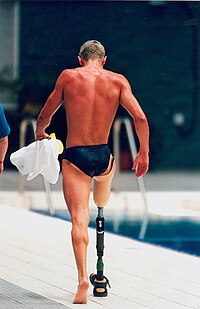
Photo from wikipedia
INTRODUCTION Erectile dysfunction (ED) affects to some degree approximately 52% of the male population aged 40-70 years. Many men do not respond to, or are precluded from using, pharmaceutical treatments… Click to show full abstract
INTRODUCTION Erectile dysfunction (ED) affects to some degree approximately 52% of the male population aged 40-70 years. Many men do not respond to, or are precluded from using, pharmaceutical treatments for ED and are therefore advised to consider penile prostheses. Different types of penile prosthesis are available, such as inflatable penile prostheses (IPPs). IPPs consist of a pair of inflatable cylinders inserted into the corpora cavernosa (CC). During inflation/deflation of these cylinders, the CC and other surrounding tissues such as the tunica albuginea (TA) are highly impacted. Therefore, it is critical to understand the mechanics of penile tissues for successful implantation of IPPs and to reduce tissue damage induced by IPPs. OBJECTIVES We explored the importance of the biomechanics of penile tissues for successful IPP function and reviewed and summarized the most significant studies on penile biomechanics that have been reported to date. METHODS We performed an extensive literature review of publications on penile biomechanics and IPP implantation. RESULTS Indenters have been used to characterize the mechanical behavior of whole penile tissue; however, this technique applied only local deformation, which limited insights into individual tissue components. Although one reported study addressed the mechanical behavior of TA, this investigation did not consider anisotropy, and there is a notable absence of biomechanical studies on CC and CS. This lack of understanding of penile tissue biomechanics has resulted in computational models that use linear-elastic materials, despite soft tissues generally exhibiting hyperelastic behavior. Furthermore, available benchtop/synthetic models do not have tissue properties matched to those of the human penis, limiting the scope of these models for use as preclinical testbeds for IPP testing. CONCLUSION Improved understanding of penile tissue biomechanics would assist the development of realistic benchtop/synthetic and computational models enabling the long-term performance of IPPs to be better assessed.
Journal Title: Sexual medicine reviews
Year Published: 2023
Link to full text (if available)
Share on Social Media: Sign Up to like & get
recommendations!